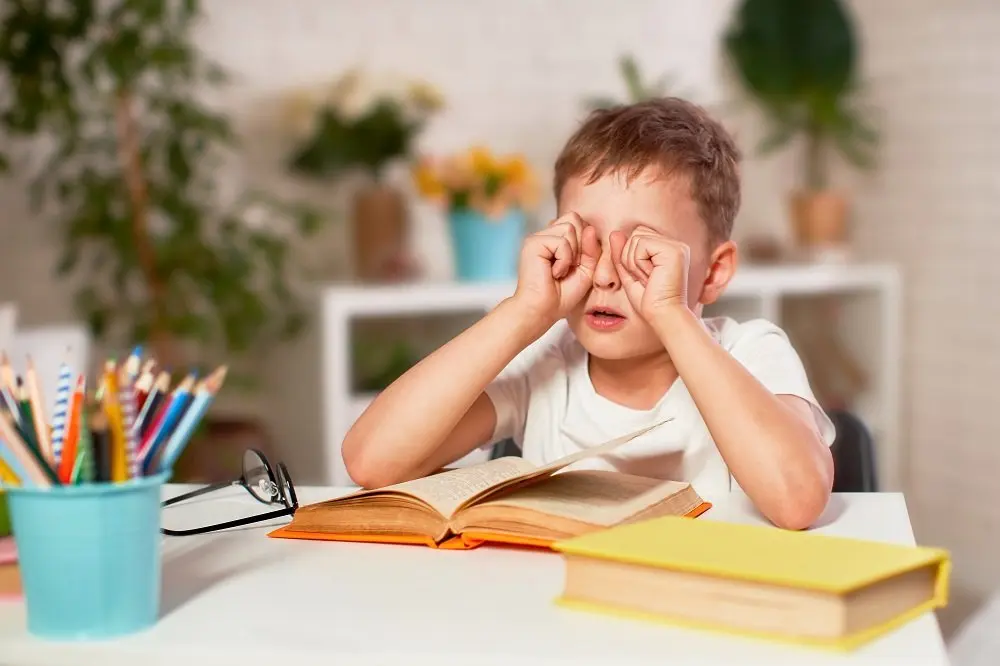As education nowadays is switching digitally from textbooks to tablets, children are spending more time on screens than ever before. Online classes, e-books, and digital learning platforms have made studying more convenient, but they also come with a hidden drawback i.e., eye strain.
Many parents notice their kids complaining of tired eyes, headaches, or difficulty focusing, but often ignore it, assuming a temporary problem. In reality, eye strain in children is becoming the most common issue and understanding the reasons for eye strain in children can help parents take timely steps to protect their vision.
Increased screen exposure

Long term usage of digital screens is the most obvious reason for eye strain in kids these days. Online classes, digital homework, and watching phones in leisure time mean that many children spend several hours a day staring at electronic devices. Unlike printed books, digital screens generate blue light which makes it difficult to focus and requires constant eye strain. Eventually this can be the cause of visual fatigue, blurred vision and headaches.
Poor posture and comfort design
Kids often lie down, slouch on the bed, or sit too close to the screen when they use devices. In starting we ignore these habits but bad posture can cause neck and eye pain. Eye strain is more likely to occur when the screen is too close because it requires more effort for the eyes to focus. Moreover poor lighting in the room either too dim or too bright, can increase the problem by making it difficult for the eyes to adjust.
Inconsistent blinking
When children are engrossed in screen they tend to blink more often than usual, which reduces natural lubrication of the eyes, causing dryness, irritation, and fatigue. To help reduce strain, parents should encourage children to follow the 20-20-20 rule. It suggests that for every 20 minutes spent on a screen, children should look at something 20 feet away for at least 20 seconds.
Inadequate lighting
Another factor that contributes to eye strain is improper lighting during study or screen use. The eyes have to constantly adjust to a screen that is too bright compared to the surrounding light.
Glare from shiny book pages or badly placed lights can make it hard for children’s eyes to stay comfortable. Using anti-glare screen protectors and making sure the lighting is adjusted will help their eyes feel less strain.
Uncorrected vision problem
You must have noticed how children sometimes sit too close to the television, rub their eyes often, or even avoid reading altogether. Most of the time children may not always express their discomfort or even realize that their vision is not normal and parents assume it’s just a habit. In reality, these could be signs of uncorrected vision problems like nearsightedness or farsightedness. If left untreated the eyes are forced to work harder and it may lead to constant strain.
Extended study hours
Children preparing for exams or following strict study schedules often spend hours focused on books or notebooks without taking breaks. Continuous near work does not give the eye muscles a chance to relax resulting in symptoms like tiredness, watery eyes, or even a burning feeling. This makes it very clear that long screen time is not only the reason behind eye strain but traditional study habits can also be the cause.
Insufficient outdoor exposure
Spending less time outdoors can also be a major reason for eye strain. Playing outside allows the eyes to naturally shift focus from near to distant objects, allowing muscles to relax. With more time spent indoors, children miss out the natural rest making their eyes more prone to strain.
Lack of routine eye check-ups
Many cases of eye strain in children remain undiagnosed simply because parents do not schedule regular eye check-ups. A thorough eye exam can detect early signs of vision problems and prevent complications later. These routine check ups are crucial for children with a family history of eye conditions or those who are already facing some symptoms.
Conclusion
As children continue to engage with screens for both education and entertainment eye strain is no longer a rare issue. Minor signs like rubbing eyes, frequent headaches, or difficulty concentrating should never be ignored, as they can lead to severe vision concerns. Parents and teachers must stay alert and encourage activities that protect children’s eyes such as regular breaks, playing outdoors and routine eye exams.
If you are in Kanpur Dr. Jawahar Lal Rohatgi Memorial Eye Hospital is a trusted place to ensure the best care for your child’s eyes. They provide a wide range of services, from routine check-ups to advanced treatments. Their expert team of specialists ensures that children and adults both receive the highest standard of care for long-term vision health.





 Call Us Now
Call Us Now
Leave a Reply